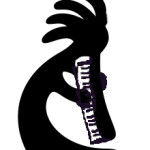Possible New Technque for Tuning
Tagged: Hohner Piano 26, pinging, tuning
- This topic has 8 replies, 3 voices, and was last updated 8 years, 3 months ago by
 Kevin.
Kevin.
-
AuthorPosts
-
January 10, 2016 at 4:25 pm #6711
 LowboyParticipant
LowboyParticipantHi,
Sorry for posting so much, but I uncovered a lot stuff this weekend. This will be my last post until I can describe the discovery of a hidden source (and probably the most prominent source) of leaks in the Hohner HM-26/27/32 series of melodicas. Hint: there is a gasket that is not compressed by a mating surface and that is not attached to a fully solid surface. If the gasket pulls up or loosens, it creates a leak and may even sound a note. On to tuning.
I tried to check tuning with the cover off my melodica by attaching my tuner to the body of the instrument and pinging a reed with a tool. See photos below. I had moderately encouraging success. It worked. It worked with the tuner set to vibrate or microphone. Tuner positioning on the instrument was important. There are two possible issues. All the notes showed tuning about 6 to 9 cents sharp (even though when tested as an assembled unit, the melodica tuning was not sharp nor that consistent). Second, randomly, a few notes just would not trigger the tuner, though changing the position of the tuner could resolve that issue. I did not actually tune a reed to see if the tuning changed as indicated by the tuner. Further development could result in a melodica that could be tuned with the cover off or a technique that could enable tuning of any melodica with the cover off.
Daren this might be a feature to think about as you explore melodica designs.
I also used my air compressor to blow air at reeds to get the reeds to sound. It was possible, but difficult, to get the reeds to sound because the reeds are surrounded by walls. But when I did get a reed to sound, the sound was fairly loud and distinct compared to sound of the air flow. Hence this might work as a method for tuning a melodica with the cover off and saving lots of time. Further development is needed.
Photos below.
Regards,
Lowboy
Tuning 1

Tuning 2
 January 11, 2016 at 12:58 am #6713
January 11, 2016 at 12:58 am #6713 Alan BrintonParticipant
Alan BrintonParticipantI have tried pinging the reeds with a guitar pickup, Tom. I’m skeptical about tuning in this way or by blowing air across the reeds, because of the extent to which where and how you blow into the instrument affects sound and tuner readings. For example, I get different readings (at the low end, at least) using a mouthpiece than I do blowing directly into the melodica, and also for the melodica in its shell and the melodica out of its shell. I haven’t experimented systematically with this. But I suspect that there are differences between “true” tuning of the reeds and tuning in relation to how it actually plays. It may even be that the melodica is best tuned relative to the particular player. Given the extent to which “Lowboy” technique involves so much manipulation of notes, it might be that “true” tuning is actually best for you. If my theory is right, though, absolute or true tuning of the reeds may not be a viable approach for melodica tuning in general. Alternatively, maybe I’m all wet on this.
I recently acquired an electric engraver that I plan to try using next time I do some tuning. http://www.amazon.com/gp/product/B0060C7PDM?psc=1&redirect=true&ref_=oh_aui_search_detailpage
January 11, 2016 at 11:19 am #6715 LowboyParticipant
LowboyParticipantHi Alan,
Yes, there is a lot to consider when it comes to tuning. Developing this cover-less tuning technique could take lots of experimenting without a good return. I do remember in the Hohner museum PR film, a clip of a manufacturing technician tuning reed plates in an open fixture with air blowing on the reeds. But it was unclear if the reed plates were for melodicas or harmonicas.
I am not too fussy when it comes to tuning yet. Though I just sent another melodica to the Hohner Shop for tuning. Every note was flat and I asked them to tune it up to A = 440 when blowing medium hard. I simple did not want to spend hours tuning this melodica until I have a chance to experiment with one that is beat up and where I have nothing to lose.
Regards,
Lowboy
January 11, 2016 at 3:31 pm #6717 Alan BrintonParticipant
Alan BrintonParticipantFactory tuning must be done with the reeds exposed, and I’m pretty sure that’s what’s shown in the Hohner photos I’m remembering. I can’t think how else they would do it, and factory tuning on new Suzukis and Yamahas is pretty good. So my misgivings are probably misplaced. Your experimentation is certainly worthwhile. If it works, the lowest 3 notes or so might need further adjustment.
January 11, 2016 at 10:36 pm #6718 LowboyParticipant
LowboyParticipantHi Alan,
I think your misgivings are well placed actually. In a factory environment, you can control the reed plate fixture and it can be solid, offering no sympathetic vibrations.
Once mounted in the melodica, tuning readings, particularly when checked by vibration, include the vibrations of the melodica body. That is why, I believe, some of the notes I pinged did not produce any reading until I changed the tuner position. Many other notes produced readings that were too uniform to believe. It would take a development effort to perfect this technique.
I am not going to develop it. I had forgotten people may have explored this possibility.
I just imagined having a post inside the reed chamber where you could attach a tuner and tune the whole melodica with the cover off! What a time saver.
Regards,
Lowboy
January 12, 2016 at 4:59 pm #6721 KevinParticipant
KevinParticipantI would think there is a difference in air pressure between pinging reeds and blowing?
Pinging would give you the true vibration frequency of a reed without air affecting it.
But once the reed is enclosed in the reed chamber the amount of air pressure would affect it’s vibration.
Isn’t this the basis of reed-bending?January 13, 2016 at 9:36 pm #6724 LowboyParticipant
LowboyParticipantVery interesting Kevin. That could explain why all the tuning readings done by pinging were sharp by 6 to 9 cents or more.
Based on the fact that you can bend a note with high pressure, high air flow, I agree with you that bending is about having a higher pressure on one side of the reed than the other. The reed still vibrates back and forth, but it does so off center and perhaps with a longer stroke on the low pressure side than the high pressure side.
That is my thoughts just based on common sense. But I could be all wet.
Regards,
Lowboy
January 14, 2016 at 6:44 pm #6728 Alan BrintonParticipant
Alan BrintonParticipantLowboy,
I’ve embarked on a new tuning project, about which I’ll report shortly. But it occurs to me, as I’m pinging reeds after scraping, that for the approach you’ve been considering the pickup should be attached to the pinging device. I ping with a straight edge razor, as it’s light, easy to get the corner under the reed, and without risk produces very clear pinging. That wouldn’t provide a good mount for a pickup. I don’t really know much about pickups other than the standard kinds of guitar pickups, but I do believe that pickup via the pinging device would produce very clear readings, namely the kind I’m hearing in my pinging. The heavier and more inflexible the pinging device is, of course, the more risk.
I wouldn’t give up on your approach. The objective would be, I think, to get clean, consistent readings, and then make some determinations about the relationship between the “true” (pinging) tuning and satisfactory tuning for your playing. Possibly whatever issue there is here could be addressed by determining the pinging tuning relative to a slightly different standard.
Alan
January 14, 2016 at 9:50 pm #6732 KevinParticipant
KevinParticipantLowboy,
Somewhere I have read (tried to find it again) that pump organ manufactures tuned their reeds sharp because they knew after being seated and under pressure they would play flat.I don’t know if this is the case with accordion and harmonicas?
But it does seem the case with the new melodicas I buy they are sharp rather than flat?I assume that pitch pipe builders get their reeds exactly right? How hard can it be?
-
AuthorPosts
- You must be logged in to reply to this topic.
